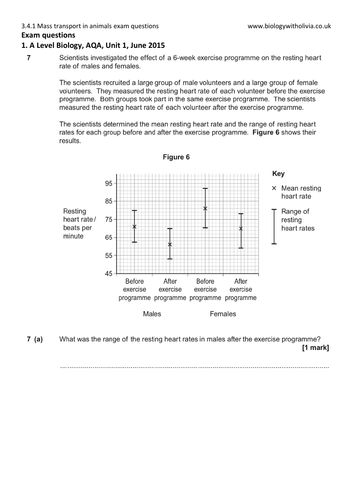In this video I explain ALL of the content required for the Mass Transport in Animals section for AQA A Level BiologyThis includes. Surface areaVolume ratio small animals have large SAV for sufficient exchange.

Animal Tissues Study Biology Tissue Biology Biology Lessons
The Control of Gene Expression A Level only 9.

. How to approach the Cardiac Cycle and answer A-level Biology Questions on mass transport in animals. Large animals have small SAV ratio. This website makes use of cookies.
Haemolymph bathes the organs and re-enters the heart through. Lots of past paper questions. Explain the part of the oxygen dissociation curve where there is a low saturation of haemoglobin with oxygen.
None of the haemoglobin molecules are carrying any oxygen. The heart uses blood vessels to transport these substances around the body. 0 saturation of haemoglobin with oxygen.
The diffusion or transport distance in these organisms are very small so essential nutrients or molecules are able to reach the necessary parts of the cell efficiently. Size large organisms that have cells further from the surface have surface-diffusion distance increased. Where pO2 is low eg in respiring tissues haemoglobin has a low affinity for oxygen.
Cardiac Cycle of the Heart and Transport in. None of the haemoglobin molecules are carrying any oxygen. A Level Biology Benedicts test for reducing sugars non-reducing sugars and starch A level biology Monosaccharides disaccharides and polysaccharides A level biology.
Resources About Services Blog Contact. Volume ratio b explain the meaning of the terms. Multicellular organisms require transport systems to supply their cells and remove waste products.
They have one main blood vessel the dorsal vessel which delivers blood haemolymph into the haemocoel body cavity due to the pumping of a tubular heart in the abdomen. These are the answers to the Transport in Animals practice questions for A-Level Biology. Explain the part of the oxygen dissociation curve where there is a low saturation of haemoglobin with oxygen.
Transport in Animals a explain the need for transport systems in multicellular animals in terms of size level of activity and surface area. Where pO2 is low eg in respiring tissues haemoglobin has a low affinity for oxygenIt releases oxygen rather than combining with it. So outer cells would use all the resources.
A-Level AQA Biology Exchanging Substances - Mass Transport in Animals past paper questions with mark schemes and examiner reports. Learn vocabulary terms and more with flashcards games and other study tools. Click card to see definition.
Explain the circulatory system in insects. Email infocurriculum-presscouk Phone 01952 271 318. Level A Level Subject Biology Exam Board OCR Module Exchangeand transport Topic Transportin animals Booklet Question Paper 1 A A B C D E 69 56 50 42 34 26.
Start studying OCR A Level Biology Transport in Animals. Genetics Populations Evolution Ecosystems A Level only 8.

3 4 1 Mass Transport In Animals Haemoglobin Cardiac Cycle Etc Exam Questions As Biology Aqa Teaching Resources

Biology Revision Questions On Transport In Animals Soma League

Transport In Animals Cie Igcse Biology Questions Answers 2020 Medium Save My Exams

Mass Transport In Animals Aqa A Level Biology Exam Question Run Through Youtube

Transport In Animals Cie Igcse Biology Questions Answers 2020 Medium Save My Exams

Mcq On Membrane Transport In Cells Easybiologyclass Biochemistry Membrane Biology Class

Mass Transport In Animals Aqa As Biology Questions Answers 2016 Easy Save My Exams

Mass Transport In Animals Aqa As Biology Questions Answers 2016 Easy Save My Exams
0 comments
Post a Comment